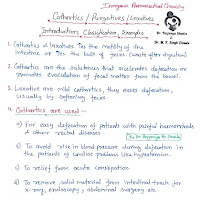Cathartics (Laxatives): Downloadable Resources (PDF & PPT)
Download comprehensive materials on cathartics (laxatives) in both PDF and PPT formats. These resources cover the different types of laxatives, their mechanisms of action, uses in treating constipation, and potential side effects. Ideal for students, healthcare professionals, and anyone seeking information on constipation relief. Download now for convenient offline access.
Keywords: Cathartics, Laxatives, PDF, PPT, Download, Constipation, Bowel Movement, Bulk-Forming, Stimulant, Osmotic, Stool Softeners, Lubricant, Mechanism of Action, Side Effects, Pharmacology, Bowel Preparation, Irritable Bowel Syndrome (IBS).
Cathartics (Laxatives): Types, Mechanisms, and Uses
Cathartics, more commonly known as laxatives, are substances that promote bowel movements. They are used to treat constipation, a condition characterized by infrequent bowel movements, hard stools, and difficulty passing stools. This document provides a comprehensive overview of laxatives, including their classification, mechanisms of action, clinical uses, and potential side effects.
Classification of Laxatives
Laxatives are classified based on their primary mechanism of action:
- Bulk-Forming Laxatives: These agents are indigestible, hydrophilic colloids that absorb water in the intestine, forming a bulky, soft gel. This gel distends the colon and promotes peristalsis (the wave-like contractions that move stool through the bowel). They are considered the safest type of laxative for long-term use. Examples include:
- Psyllium (e.g., Metamucil)
- Methylcellulose (e.g., Citrucel)
- Calcium polycarbophil (e.g., FiberCon)
- Stool Softeners (Emollient Laxatives): These agents act as surfactants, allowing water and fats to penetrate the stool, making it softer and easier to pass. They do not stimulate bowel movements directly. Example:
- Docusate sodium (e.g., Colace)
- Docusate calcium
- Lubricant Laxatives: These create a slippery coat on the intestinal contents, which eases the passage. Example:
- Mineral oil
- Osmotic Laxatives: These agents are poorly absorbed substances that draw water into the intestine through osmosis. This increased water content softens the stool and stimulates peristalsis. Osmotic laxatives can be further divided:
- Saline Laxatives: Contain magnesium or phosphate ions. Examples include:
- Magnesium hydroxide (Milk of Magnesia)
- Magnesium citrate
- Sodium phosphate (e.g., Fleet Phospho-soda) *Note: Oral sodium phosphate products have been associated with kidney injury and should be used with caution.*
- Non-absorbable Sugars: Examples include:
- Lactulose
- Sorbitol
- Polyethylene glycol (PEG) (e.g., Miralax, GoLYTELY)
- Saline Laxatives: Contain magnesium or phosphate ions. Examples include:
- Stimulant Laxatives (Irritant Laxatives): These agents directly stimulate the nerves in the colon, increasing peristalsis. They can also increase fluid and electrolyte secretion into the bowel. Stimulant laxatives are generally effective but should be used for short-term treatment only, as long-term use can lead to dependence and damage to the colon. Examples include:
- Bisacodyl (e.g., Dulcolax)
- Senna (e.g., Senokot, Ex-Lax)
- Cascara sagrada
- Castor oil *Note: Castor oil is a very potent stimulant laxative and is rarely used due to its strong effects and potential for side effects.*
- Chloride Channel Activators:
- Lubiprostone (Amitiza): Activates chloride channels in the intestine, increasing fluid secretion and promoting bowel movements. Used for chronic idiopathic constipation and irritable bowel syndrome with constipation (IBS-C).
- Guanylate Cyclase-C (GC-C) Agonists:
- Linaclotide (Linzess)
- Plecanatide (Trulance)
Increase fluid secretion and transit
Mechanism of Action (Summary)
- Bulk-Forming: Absorb water → increase stool bulk → stimulate peristalsis.
- Stool Softeners: Allow water and fats to penetrate stool → soften stool.
- Lubricant: easing the passage by coating.
- Osmotic: Draw water into the intestine → soften stool and stimulate peristalsis.
- Stimulant: Directly stimulate colonic nerves → increase peristalsis and fluid secretion.
- Chloride Channel Activators: Increase intestinal fluid secretion.
- Guanylate Cyclase-C (GC-C) Agonists: Increase intestinal fluid secretion.
Clinical Uses
- Constipation: The primary use of laxatives is to treat constipation. The choice of laxative depends on the cause and severity of constipation, as well as individual patient factors.
- Bowel Preparation: Osmotic laxatives, particularly PEG solutions, are commonly used to cleanse the bowel before colonoscopy, surgery, or other procedures.
- Irritable Bowel Syndrome with Constipation (IBS-C): Some laxatives, such as lubiprostone and linaclotide, are specifically approved for the treatment of IBS-C.
- Opioid-Induced Constipation: Opioid medications can slow bowel motility and cause constipation. Laxatives, often in combination, are used to prevent and treat opioid-induced constipation.
Side Effects
While generally safe when used as directed, laxatives can cause side effects, especially with overuse or misuse:
- Abdominal Cramping and Discomfort: A common side effect of many laxatives, particularly stimulant laxatives.
- Bloating and Gas: Especially common with bulk-forming laxatives and osmotic laxatives.
- Dehydration and Electrolyte Imbalance: Can occur with overuse of osmotic laxatives, particularly saline laxatives.
- Laxative Dependence: Long-term use of stimulant laxatives can lead to dependence, where the bowel becomes less responsive to normal stimuli and requires laxatives to function.
- Melanosis Coli: A harmless darkening of the colon lining that can occur with long-term use of anthraquinone laxatives (senna, cascara).
- Mineral Oil: Interference with absorption of fat-soluble vitamins.
It's important to use laxatives as directed and to consult a healthcare professional if you have chronic constipation or experience any concerning side effects.
Info!
If you are the copyright owner of this document and want to report it, please visit the copyright infringement notice page to submit a report.

